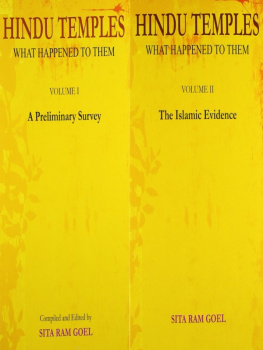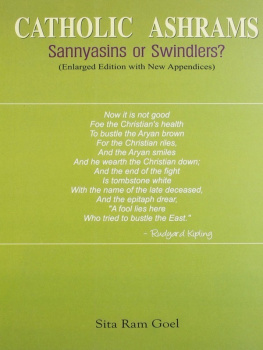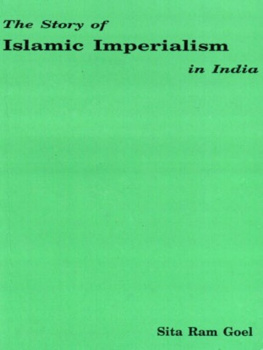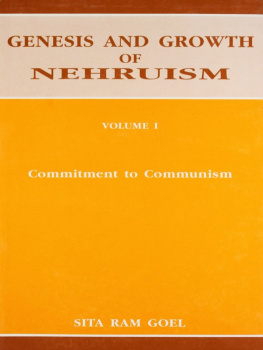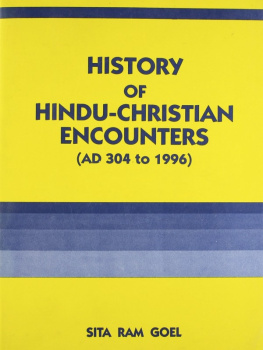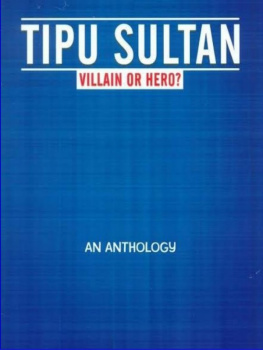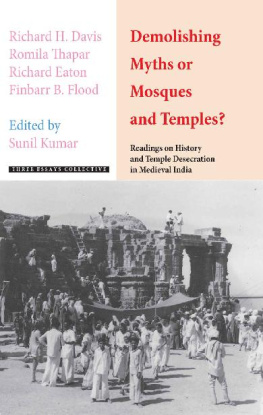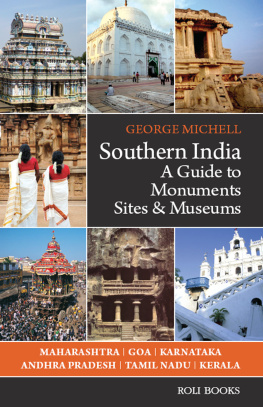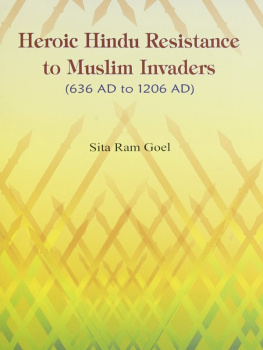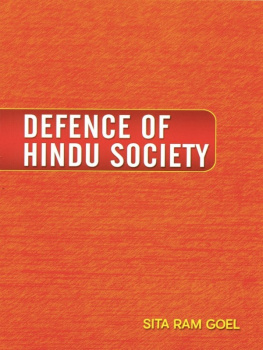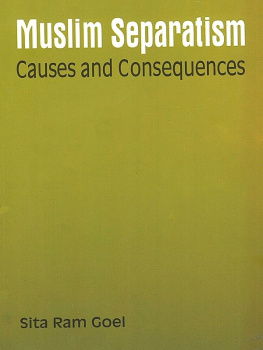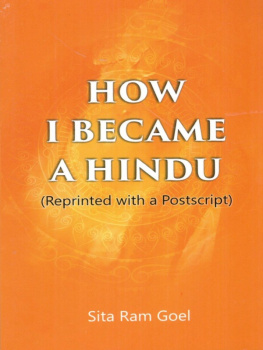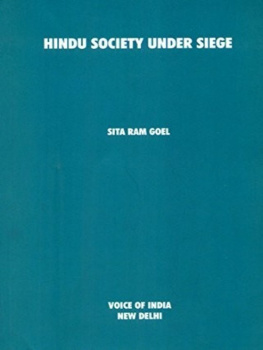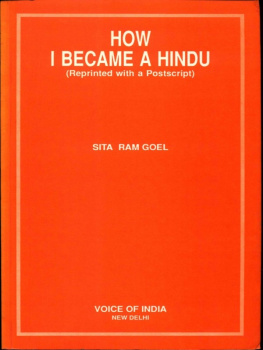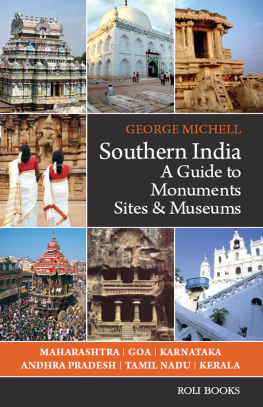HINDU TEMPLES
WHAT HAPPENED TO THEM ?
VOLUMES 1 AND 2
------------------------------------------------------------------------
Volumes 1
A Preliminary Survey
ARUN SHOURIE
HARSH NARAIN
JAY DUBASHI
RAM SWARUP
SITA RAM GOEL
Voice of India, New Delhi
Contents
Preface
1. Hideaway Communalism
2. The Tip of An Iceberg
3. Some Historical Questions
4. In the Name of Religion
5. A Need to Face the Truth
6. Historians Versus History
7. November 9 Will Change History
8. From Shilanyas to Berlin Wall
9. Rama-Janmabhumi Temple Muslim Testimony
10. Let the Mute Witnesses Speak
Appendix
Preface
The movement for the restoration of the Ramajanmabhumi Temple at Ayodhya has brought to the fore a suppressed chapter of Indias history, namely, the large-scale destruction of Hindu temples1 by the Islamised invaders. This chapter is by no means closed. The Appendix to this book provides details of many temples destroyed by Muslims all over Bangladesh as recently as October-November 1989. Currently, temples, or whatever had remained of them, are meeting a similar fate in the Kashmir valley.
This chapter, however, though significant, was only a part of the Muslim behaviour-pattern as recorded by Muslim historians of medieval India. The other parts were: 1) mass slaughter of people not only during war but also after the armies of Islam had emerged victorious; 2) capture of large numbers of non-combatant men, women and children as booty and their sale as slaves all over the Islamic world; 3) forcible conversion to Islam of people who were in no position to resist; 4) reduction to the status of zimmis or non-citizens of all those who could not be converted and imposition of inhuman disabilities on them; 5) emasculation of the zimmis by preventing them from possessing arms; 6) impoverishment of the zimmis through heavy discriminatory taxes and misappropriation of a major part of what the peasants produced; 7) ruination of the native and national culture of the zimmis by suppressing and holding in contempt all its institutions and expressions.
Nor is this behaviour pattern a thing of the past. It persisted even after the Muslim rule was over. The Muslim revivalist movements in the nineteenth century, particularly in Bengal, tried to repeat, as far as they could, the performance of the medieval Muslim swordsmen and sultans. More recently, after the Islamic state of Pakistan was carved out, Hindus have been forced to leave their ancestral homes, en masse from its western wing and in a continuous stream of refugees from its eastern wing, now an independent Islamic state of Bangladesh that came into being with the help of India. Hindu temples and other cultural institutions have more or less disappeared from Pakistan, while they continue to be under constant attack in Bangladesh.
How to understand this behaviour pattern so persistently followed over a thousand years under very different conditions and so consistent in its expression? What is its deeper ideological source?
It is rooted in Islams religious teachings, its theology and its religious laws; it derives from its peculiar conception of momins and kafirs, from its doctrines of Jihad, Darul-Islam and Darul-harb, and from what it regards as the duty of a Muslim state. Hindu India is called upon to make a deeper study of Islam than it has hitherto done. It can neglect this task at its own peril.
The present volume makes no pretence of presenting such a study, but by choice restricts itself mainly to the study of Hindu temples destroyed and desecrated and converted into mosques and khanqahs without overlooking Muslims ideology of iconoclasm; here and there, it also mentions other theological props and concomitants of the iconoclastic ideology. In the book Ayodhya retain its importance, but it does not occupy the centre of discussion. In dealing with its subject, it exercises complete fidelity to truth; unlike secularist and Marxist writers, it does not believe in re-writing and fabricating history. Its aim is to raise the informational level of our people and to make them better aware of the more persistent ideological forces at work.
Mahavira Jayanti.
April 7, 1990
Publisher
Chapter One
Hideaway Communalism
Arun Shourie
A case in which the English version of a major book by a renowned Muslim scholar, the fourthRector of one of the greatest centres of Islamic learning in India, listing some of the mosques,including the Babri Masjid, which were built on the sites and foundations of temples, using theirstones and structures, is found to have the tell-tale passages censored out;The book is said to have become difficult to get;
It is traced: And is found to have been commanded just 15 years a-o by the most influential livingMuslim scholar of our country today, the current Rector of that great centre of Islamic learning, andthe Chairman of the Muslim Personal Law Board.
Evasion, concealment, have become a national habit. And they have terrible consequences. But firstI must give you some background.
The Nadwatul-Ulama of Lucknow is one of the principal centres of Islamic learning in India. It was founded in 1894. It ranks today next only to the Darul-Ulum at Deoband. The government publication, Centres of Islamic Learning in India, recalls how the founders aimed at producing capable scholars who could project a true image of Islam before the modern world in an effective way; it recalls how Towards fulfilling its avowed aim in the matter of educational reform, it (the group) decided to establish an ideal educational institution which would not only provide education in religious and temporal sciences but also offer technical training; it recalls how It (the Nadwa) stands out today-with its
college, a vast and rich library and Research and Publication Departments housed in fine buildings-as one of the most outstanding institutions for imparting instruction in the Islamic Sciences; it recalls how A salient feature of this institution is its emphasis on independent research; it recalls how The library of the Nadwa, housed in the Central Hall and the surrounding rooms of the main building, is, with more than 75,000 titles including about 3,000 handwritten books mostly in Arabic and also in Persian, Urdu, English etc., one of the finest libraries of the sub-continent. That was written 10 years ago. The library now has 125,000 books.
Its Head
Today the institution is headed by Maulana Abul-Hasan Ali Nadwi. Ali Mian, as he is known to one and all, is almost without doubt the most influential Muslim teacher and figure today-among the laity, in government circles, and among scholars and governments abroad.
He was among the founders of the Jamaat-e-Islami, the fundamentalist organisation; but because of differences with Maulana Maudoodi, lie left it soon.
Today lie is the Chairman of the Muslim Personal Law Board.
He is a founder member of the Raabta Alam-e-Islami, the Pan-Islamic body with headquarters in Mecca, which decides among other things the amounts that different Islamic organisations the world over should receive.
He has been the Nazim, that is the Rector, of the Darul Ulum Nadwatul-Ulama since 1961, that is for well over a quarter of a century. The Nadwa owes not a small part of its eminence to the scholarship, the exertions, tile national and international contacts of Ali Mian.
Politicians of all hues ---Rajiv Gandhi, V.P. Singh, Chandrashekhar-seek him out.
He is the author of several books, including the well known
Next page
